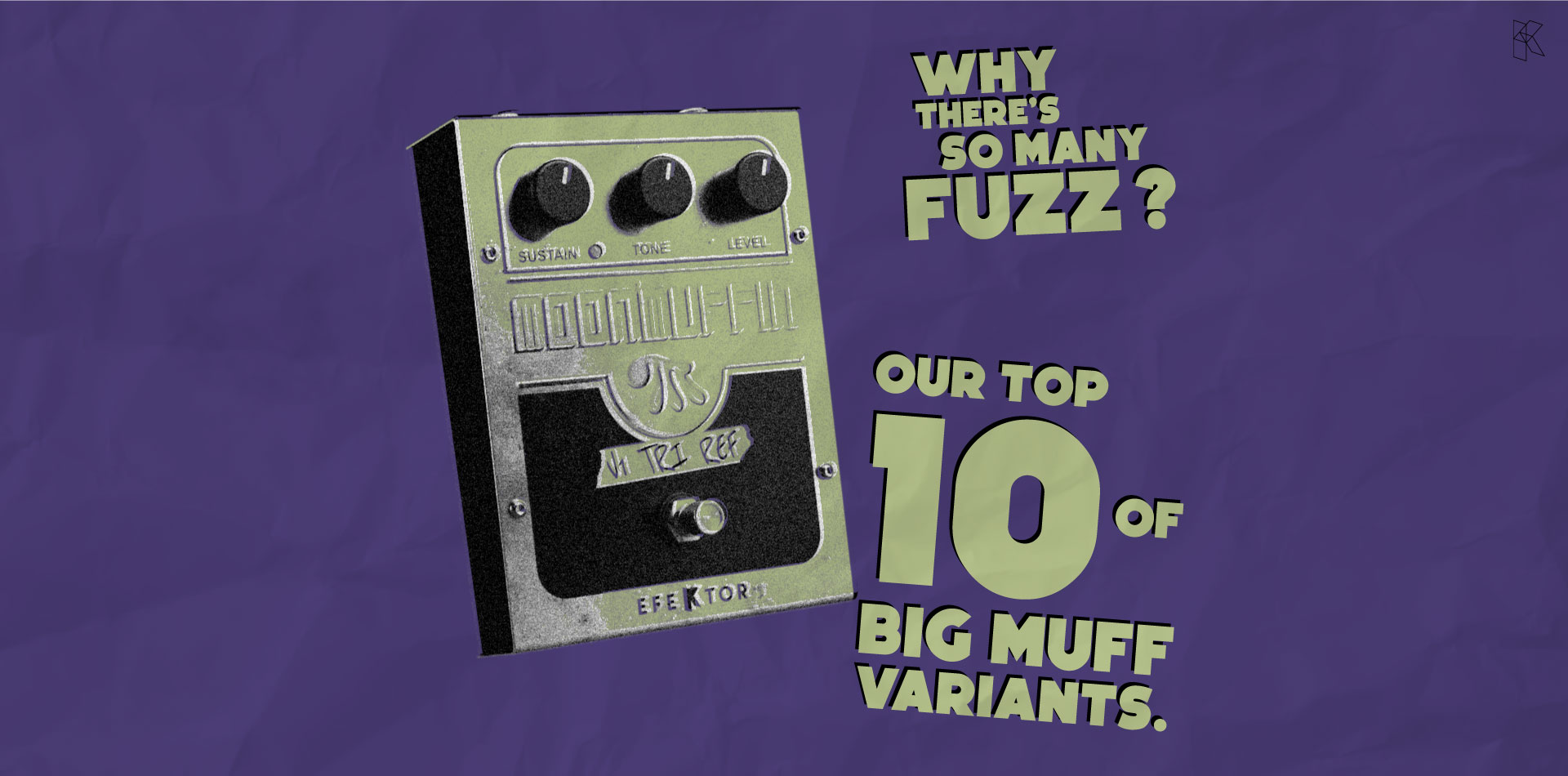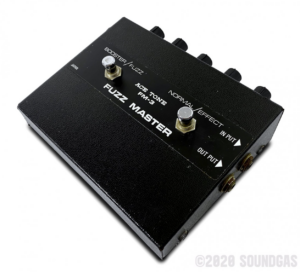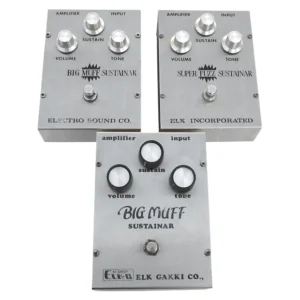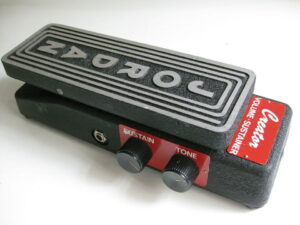This comprehensive exploration delves into the rich tapestry of the top 10 Big Muff variants. Beginning with the iconic Triangle Pi Reference Board, the journey traverses through the evolution of the Big Muff circuit, from its humble beginnings in the late 1960s to its modern incarnations. From the classic “Standard” Triangle Big Muff Pi to the enigmatic Black Russian Version, each pedal offers a unique blend of nostalgia, innovation, and sonic exploration. Let’s dig deeper on the Big Muff lineage and its enduring impact on the world of guitar effects.

Source: https://pedaltown.nl/en/
In the realm of guitar pedals, few names evoke as much reverence and fascination as the Big Muff Pi. Since its inception in 1969, this iconic distortion pedal has left an indelible mark on the world of music, shaping the sounds of countless artists across genres. Yet, what truly sets the Big Muff apart is its remarkable adaptability and enduring legacy, evident in the plethora of variants that have emerged over the decades. In this comprehensive exploration, we embark on a journey through time and sound, delving deep into the history, evolution, and sonic nuances of the top 10 Big Muff variants.
Historical Background
To understand the genesis of Big Muff variants, we must first unravel the historical tapestry of the pedal itself. Conceived by Electro-Harmonix founders Mike Matthews and Bob Myers in the late 1960s, the Big Muff Pi emerged during a period of unprecedented experimentation in guitar effects. Inspired by the burgeoning psychedelic and rock movements of the era, Matthews and Myers sought to create a pedal that could deliver the soaring, saturated tones craved by musicians.
The original Big Muff circuit, often referred to as the “Triangle Pi,” laid the foundation for subsequent variants. Featuring a simple yet powerful transistor-based design, the Triangle Pi captured the essence of vintage fuzz while offering unparalleled sustain and clarity. Its release in 1969 marked the dawn of a new era in guitar effects, setting the stage for a wave of innovation and imitation.
As the 1970s unfolded, demand for the Big Muff skyrocketed, prompting Electro-Harmonix to expand its production and distribution. Yet, with success came imitation, as rival manufacturers sought to capitalize on the pedal’s popularity. Thus began a cycle of emulation and iteration, with companies around the world producing their own interpretations of the Big Muff circuit.
Why So Many Variants?
The proliferation of Big Muff variants can be attributed to several factors, each contributing to the rich diversity of the pedal’s lineage. Firstly, the simplicity and versatility of the original circuit lent itself to experimentation and modification. Guitarists and engineers alike were drawn to the Big Muff’s modular design, allowing for easy substitution of components and tweaking of parameters.
Secondly, as the demand for distortion pedals grew, so too did the need for differentiation and specialization. Manufacturers sought to carve out their niche in the market by offering unique twists on the classic Big Muff sound. This led to the emergence of variants tailored to specific genres, playing styles, and sonic preferences.
Furthermore, the evolution of technology and manufacturing processes played a significant role in the proliferation of Big Muff variants. Advancements in component sourcing, circuit design, and production techniques enabled manufacturers to experiment more freely and push the boundaries of pedal design.
Evolution of the Components
Central to the evolution of Big Muff variants is the constant refinement and experimentation with component values and types. From resistors and capacitors to transistors and diodes, every element of the circuit plays a crucial role in shaping the pedal’s sound.
Early variants, such as the Triangle Pi and Standard Triangle Big Muff Pi, featured components sourced from readily available stock, resulting in a relatively consistent sound across units. However, as manufacturing processes improved and component availability fluctuated, subsequent variants began to diverge in tonal character.
One of the most notable changes in component values occurred in the transition from the Triangle Pi to the Rams Head variants. Larger resistors in the tone section and revised capacitor values led to a more pronounced midrange scoop and smoother overall tone. Similarly, variations in transistor types and clipping diodes influenced the pedal’s distortion characteristics, giving rise to distinct tonal signatures.
Exploring the Top 10 Big Muff Variants:
1. Triangle Pi PerfBoard:
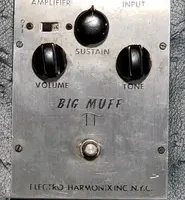
Image Source: https://www.sweetwater.com/used/listings/133996-used-electro-harmonix-vintage-electro-harmonix-big-muff-pi-v1-triangle-19691970-perf-board-circuit
The Triangle Pi Reference Board, the holy grail of Big Muff enthusiasts and pedal historians alike. Picture this: it’s the late 1960s, Electro-Harmonix is just a fledgling company, and Bob Myers and Mike Matthews are tinkering away in a dimly lit workshop. This early perf board version, with its oversized collector resistors and point-to-point wiring, is a testament to the DIY ethos that defined the era. It’s raw, it’s unrefined, but my oh my, does it pack a punch. From its massive, high-gain sound to its slightly muddy undertones, the Triangle Pi sets the stage for what’s to come – a distortion revolution unlike any other.
2. “Standard” Triangle Big Muff Pi:

Source: https://reverb.com/p/electro-harmonix-big-muff-pi-v1-triangle
Fast forward to the early 1970s, and we have the “Standard” Triangle Big Muff Pi – the workhorse of the Big Muff family.
t’s like the reliable old friend you can always count on to deliver the goods. With its larger resistors in the tone section and ceramics replacing electros, this variant strikes the perfect balance between aggression and clarity. It’s the sound of rock ‘n’ roll distilled into a single pedal – gritty, raucous, and utterly irresistible. The moniker ‘Triangle’ derives from the layout of its three controls – Volume, Sustain, and Tone – a design that pays homage to the 2018 50th-anniversary commemoration.
Additionally, it boasts a luminous LED indicator, though one might argue that its blooming harmonics, lush sustain, and full-bodied fuzziness serve as sufficient clues to its activation.
3. “Rams Head” Big Muff Pi 47nf Version:
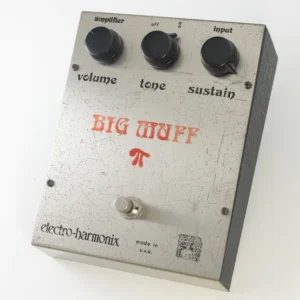
Image source: https://intl.ishibashi.co.jp/products/03-2800001848308
Venturing further into the Big Muff chronicles, we encounter the illustrious Rams Head 47nf Version – a true gem from the early 1970s.
Named after its distinctive enclosure graphics, this variant represents a leap forward in Big Muff evolution. With its larger .47uF capacitors and revised filter configurations, this variant delivered a harmonically rich sound teeming with vintage charm. Embraced by luminaries like David Gilmour, its legacy endures as a paragon of classic fuzz tonality, immortalized in the annals of rock history.
4. Rams Head “White Can” Big Muff Pi:
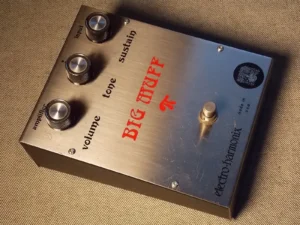
Image Source: https://reverb.com/item/126207-big-muff-ram-s-head-fuzz-pedal-white-can-1974-36999-transistors-collector-cond
The Rams Head “White Can” Big Muff Pi – a rare beauty from the mid-1970s that’s as elusive as it is iconic.
This sixth iteration in the V2 circuit lineage epitomizes Electro-Harmonix’s quest for sonic perfection. Adorned with distinctive white axial poly film capacitors, this variant introduced subtle yet significant modifications to the circuitry, including revised filter configurations and altered resistor values. Resulting in a tonal palette characterized by its warm, articulate response, this rendition found favor among discerning musicians seeking a blend of vintage warmth and modern versatility.
5. Rams Head 1975 Big Muff Pi:
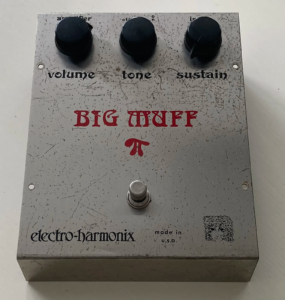
Image Source: https://www.ebay.com/itm/325879788310
Step back in time to 1975 and you’ll find yourself in the presence of greatness – the Rams Head 1975 Big Muff Pi. With its subtle tweaks in resistor values and capacitor configurations, this variant offers a modern take on a classic design. It’s like taking a trip down memory lane, only to find that everything sounds better than you remember. From its crisp, articulate highs to its thunderous lows, it’s a sonic journey worth taking. The Ram’s Head, produced between 1973 and 1977, earns its name from the Electro Harmonix emblem, a small ram’s head nestled at the pedal’s bottom right corner. Revered for its association with David Gilmour, who utilized it for his iconic solos from 1976 onward, particularly on Pink Floyd’s albums like “Animals” and notably “The Wall,” including the unforgettable moment in “Comfortably Numb.” Dinosaur Jr.’s J. Mascis also favors this variant for its pronounced sustain, warm tonality, and subdued highs compared to the Triangle.
6. Black Russian Version:
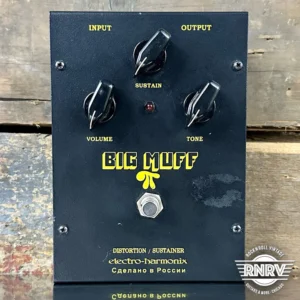
Image Source: https://rocknrollvintage.com/products/2007-electro-harmonix-black-russian-big-muff-pi
Now, let’s fast forward to the early 1990s and venture into the world of the Black Russian Version – a pedal that’s as enigmatic as it is alluring. With its larger value resistors and unique clipping capacitors, it offers a sound that’s both familiar and intriguing. It’s like exploring uncharted territory, where every twist and turn reveals a new sonic landscape waiting to be discovered. From its gritty, raw texture to its thunderous bottom end. Due to durability issues with the Green Russian’s paint, Electro Harmonix transitioned to a more resilient black finish in 1998. Serving as the final Russian-manufactured version before production shifted to the USA, the Black Russian holds a special place among collectors. While sharing a circuit with its predecessor, subtle distinctions emerge, notably in its weightier bass response. Some deem it optimal for bass applications, a sentiment echoed by Muse’s Chris Wolstenholme, showcasing its capability to produce awe-inspiring tones. Ideal for low-tuned guitars.
7. “NYC Reissue” Big Muff Pi:
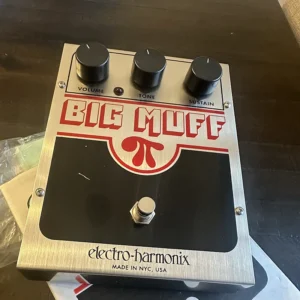
Image Source: https://reverb.com/p/electro-harmonix-big-muff-pi?ended_listing=78010443


